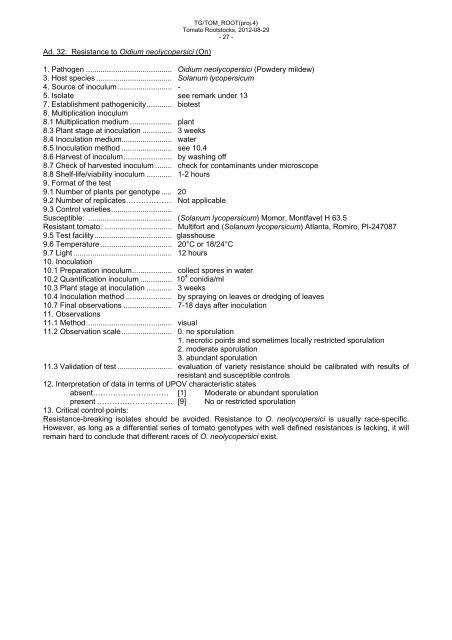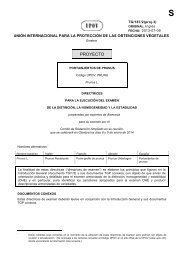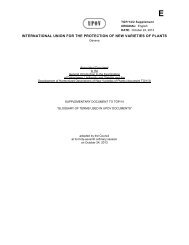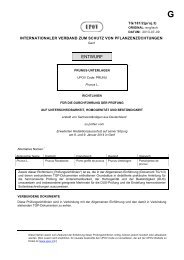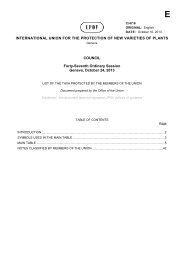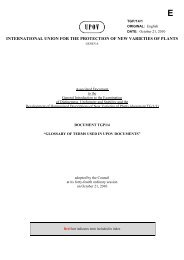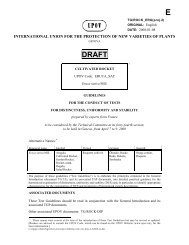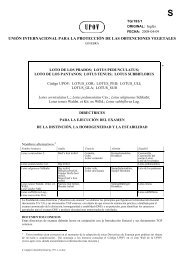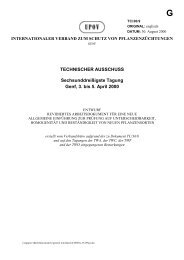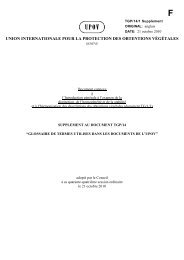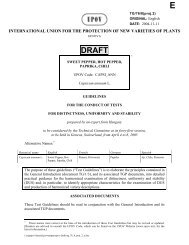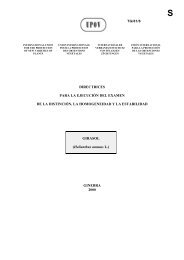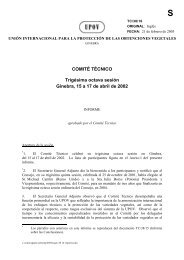E - International Union for the Protection of New Varieties of Plants
E - International Union for the Protection of New Varieties of Plants
E - International Union for the Protection of New Varieties of Plants
Create successful ePaper yourself
Turn your PDF publications into a flip-book with our unique Google optimized e-Paper software.
Ad. 32: Resistance to Oidium neolycopersici (On)<br />
TG/TOM_ROOT(proj.4)<br />
Tomato Rootstocks, 2012-08-29<br />
- 27 -<br />
1. Pathogen ......................................... Oidium neolycopersici (Powdery mildew)<br />
3. Host species .................................... Solanum lycopersicum<br />
4. Source <strong>of</strong> inoculum.......................... -<br />
5. Isolate see remark under 13<br />
7. Establishment pathogenicity............ biotest<br />
8. Multiplication inoculum<br />
8.1 Multiplication medium .................... plant<br />
8.3 Plant stage at inoculation .............. 3 weeks<br />
8.4 Inoculation medium........................ water<br />
8.5 Inoculation method ........................ see 10.4<br />
8.6 Harvest <strong>of</strong> inoculum....................... by washing <strong>of</strong>f<br />
8.7 Check <strong>of</strong> harvested inoculum ........ check <strong>for</strong> contaminants under microscope<br />
8.8 Shelf-life/viability inoculum ............ 1-2 hours<br />
9. Format <strong>of</strong> <strong>the</strong> test<br />
9.1 Number <strong>of</strong> plants per genotype ..... 20<br />
9.2 Number <strong>of</strong> replicates……………… Not applicable<br />
9.3 Control varieties.............................<br />
Susceptible: ........................................ (Solanum lycopersicum) Momor, Montfavet H 63.5<br />
Resistant tomato: ................................ Multi<strong>for</strong>t and (Solanum lycopersicum) Atlanta, Romiro, PI-247087<br />
9.5 Test facility..................................... glasshouse<br />
9.6 Temperature .................................. 20°C or 18/24°C<br />
9.7 Light ............................................... 12 hours<br />
10. Inoculation<br />
10.1 Preparation inoculum................... collect spores in water<br />
10.2 Quantification inoculum ............... 10 4 conidia/ml<br />
10.3 Plant stage at inoculation ............ 3 weeks<br />
10.4 Inoculation method ...................... by spraying on leaves or dredging <strong>of</strong> leaves<br />
10.7 Final observations ....................... 7-18 days after inoculation<br />
11. Observations<br />
11.1 Method......................................... visual<br />
11.2 Observation scale........................ 0. no sporulation<br />
1. necrotic points and sometimes locally restricted sporulation<br />
2. moderate sporulation<br />
3. abundant sporulation<br />
11.3 Validation <strong>of</strong> test .......................... evaluation <strong>of</strong> variety resistance should be calibrated with results <strong>of</strong><br />
resistant and susceptible controls<br />
12. Interpretation <strong>of</strong> data in terms <strong>of</strong> UPOV characteristic states<br />
absent………………………… [1] Moderate or abundant sporulation<br />
present ………………………… [9] No or restricted sporulation<br />
13. Critical control points:<br />
Resistance-breaking isolates should be avoided. Resistance to O. neolycopersici is usually race-specific.<br />
However, as long as a differential series <strong>of</strong> tomato genotypes with well defined resistances is lacking, it will<br />
remain hard to conclude that different races <strong>of</strong> O. neolycopersici exist.


